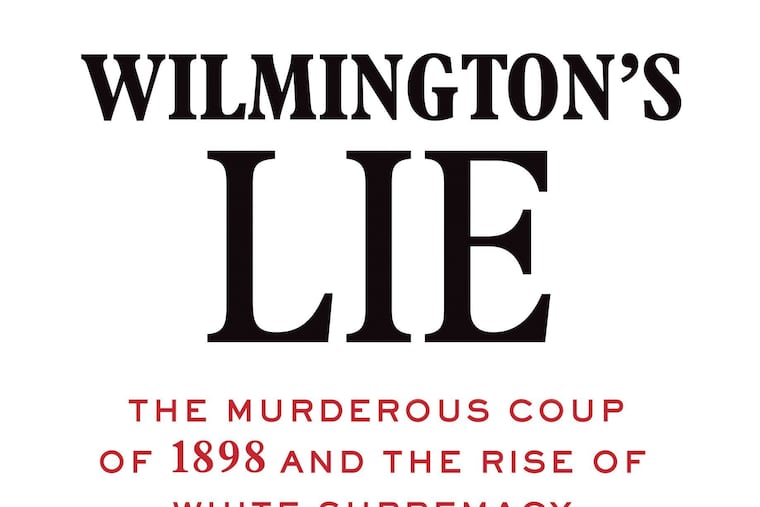‘Wilmington’s Lie’: This little-known 1898 coup in North Carolina had an ugly legacy | Book review
In the last years of the 19th century, a network of white extremists plotted, organized, and executed a plan to take over the state of North Carolina. They started in Wilmington.

Wilmington’s Lie
The Murderous Coup of 1898 and the Rise of White Supremacy
By David Zucchino
Atlantic Monthly Press. 336 pp. $28.
They got away with it.
And we’re still living in the shock wave.
That’s the dumbfounding, true story in David Zucchino’s Wilmington’s Lie, one so lacerating, so appalling you often can’t believe what you’re reading. I hope this powerful book helps preserve this bad memory for a long time.
In the last years of the 19th century, a network of white extremists plotted, organized, and executed a plan to take over the state of North Carolina. The dirty jewel in this crown was the violent overthrow of the government of Wilmington, a prosperous and largely integrated port city along the Cape Fear River.
On Nov. 11, 1898, armed white mobs swept the town, destroying black businesses and homes, killing at least 60 people, banishing “obnoxious” blacks and whites, and replacing everyone from mayor to postman with supremacists.
Not a single charge. Not a single arrest. A halfhearted federal investigation fizzled. Many of those who spearheaded the takeover went on to long political careers. And their ideas and methods are still with us, in an ugly legacy of voter suppression, gerrymandering, obstruction, and intimidation.
» READ MORE: Spring 2020's best books: Hilary Mantel ends her trilogy, Elena Ferrante begins again
One of the few armed insurrections in our peacetime history, Wilmington 1898 is little known, even in North Carolina. That’s the “lie” of the title: The victors wrote the history, blaming African Americans and, with diseased nostalgia, celebrating the murderers as heroes.
Zucchino is your ideal guide. The Pulitzer Prize-winner and former Inquirer staffer is a tireless, resourceful reporter, an incisive social analyst, and a direct, often elegant writer.
He surveys the post-Civil War power struggle between antislavery Republicans and racist, patrician Democrats. At one point, “Fusionist” Republicans who favored integration ran North Carolina, with some statewide offices and legislative seats held by African Americans. The Democrats fought back on top, but in 1894 the Fusionists won, aided by an interracial voting coalition that hardened supremacist resolve.
Wilmington in the 1890s was a vigorous economic and political engine primed by whites and blacks alike; in fact, most voters were black. White racists called this “the intolerable situation” — they claimed they hated the way blacks ruled over them, but what they really hated was equality. We watch the growth of the Ku Klux Klan terror group and the formation of local secret cells of supremacists, “White Government Unions,” and other cabals determined to restore “the old order” of white domination.
We meet Alex Manly, editor of the African American newspaper The Record. We meet many professional white instigators. Hysterical opinion writer and public speaker Rebecca Latimer Felton has interracial sex on her mind. Yellow journalist Josephus Daniels loves stoking the myth of the “black beast rapist” hungry for white women. (Zucchino carefully documents the lack of evidence for this myth, a pretext for lynching for the next 70 years.)
Outraged at Felton’s sick sex rants, Manly publishes an op-ed saying that both whites and blacks sleep across the racial line. That will be match to tinder. Zucchino skillfully builds suspense as the insurrection is coordinated and manned. We meet Confederate veteran, former Congressman, and political opportunist Col. Alfred Moore Waddell, a figurehead in the uprising. And we meet the Red Shirts, the Democratic Party’s white vigilante militia impatient to intimidate, torch, and kill.
The middle third of the book covers a few days when the streets brim with blood; it’s so well told, so eloquently illustrated, that it seems to take only minutes to read. One eyewitness wrote: “Firing began, and it seemed like a mighty battle in war time. The shrieks and screams of children, of mothers, of wives were heard. … Thousands of women, children and men rushed to the swamps and lay upon the earth in the cold to freeze and starve.”
The final third gauges the aftershocks. The Wilmington overthrow did not cause the triumph of white supremacy in the South, but it did help it spread. The first Jim Crow law passed in 1899, and the Democrats took the state in 1900, unleashing a flood of segregationist legislation to solidify white domination.
The riot leaders had fine lives afterward, with little visible regret. After initial struggles, some African American survivors found new lives. Manly and his family ended up in Philadelphia; he is buried in Fairview Cemetery in Willow Grove.
The narrative leaves us in North Carolina politics, 2018: Tried and true tactics help disenfranchise black voters, redraw districts, and establish all but permanent white majorities.
Fury; mobocracy; threats and punishments; perversion of the law — I’ll save you any too-obvious reflections on our own times.
Wilmington 1898 may seem like an exaggerated case, an outlier, a jungle spasm in an otherwise well-ordered democracy. Read Wilmington’s Lie, though, and you may come to see it as more like America than unlike.
John Timpane is the former books editor for The Inquirer.